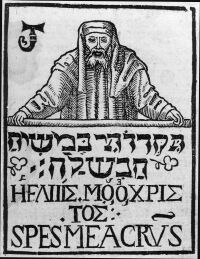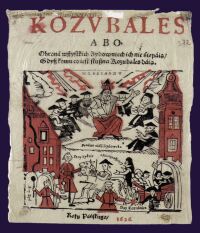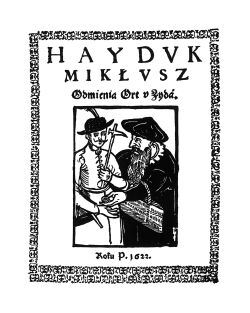





Page from the anonymous brochure, Epistola or the letter from Rabbi Samuel the Jew to another Rabbi Izaak the Jew, that Jesus of Nazareth is the true Messiah... (Kraków 1539). This is a translation of the anti-Jewish pamphlet popular in the Western Europe. The inscription under the image of the Jew says: "Christ is my hope" in Hebrew, Greek and Latin.
Title page of the story about the martyrdom of Matatjasz Kalahora (Cracovian apothecary), 1666 (?). Accused of blasphemy, he was burnt at the stake in Piotrków in 1663.
Portrait of Bohdan Chmielnicki (ca. 1595-1657), leader of the cossacks' rebellion (1648-1657). The cossack rebels and peasants massacred the noblemen and the Jews, regarding them as their worst oppressors.
The Jews were allegedly kidnapping Christian children needed for ritual murders.
The painting by Karol de Prevot, displayed at stalls of the St. Paul's church in Sandomierz shows a scene of one of the of the ritual murders that allegedly occurred in Sandomierz in 1710. Accusations of this kind often lead to trials of the individual Jews or of the whole Jewish communes. The evidence was extorted through tortures, which resulted in sentencing many innocent people to death.
|

Title page of the anonymous anti-Jewish brochure Kozubales or the apology of all the Jews... (Kraków (?) 1626). Kozubalec was a name for a charge collected from the Jews by students and priests. The name comes from the word "kozub" - basket that the Jews were taking when going to the market.
The last page of the first edition of Sefer Yewen Mezulah (Venice 1653), the chronicle of the massacre of the Polish Jews during the Chmielnicki's rebellion (1648-1652), written by Nathan Hannover (died 1653).
Satirical representation of a Jew and a Turk being taken to hell by the personified death.
Fragment of the painting of an unknown author, Death's dance, 2nd half of 17th century, Church of the Order Friars Minor, Kraków.
Charter "de non tolerandis Judaeis" prohibiting the Jews from living in Warsaw, issued by King Sigismund I the Old in 1527. The Jews were allowed to come into the city only to fairs and on market days. Due to the economic reasons in the course of time this charter was less and less strictly executed. Similar charters were issued for many other cities and towns in the First Republic, particularly in Mazowsze and Central Poland.
|

Title page of the anonymous anti-Jewish brochure, Hayduk Mikłusz exchanging ort at the Jew (Kraków 1622). The author accuses the Jews of forging money. Ort was a name for a silver coin equivalent to 10-18 groshes.
At the end of the 16th century, the wave of Counter-Reformation not only brought the persecutions of the Protestants, but also of the Jews. The latter were an easy target of such assaults because of their economic competitiveness, distinct outfit, language and religion. The accusations of profanation of the Host, alleged ritual murders and of witchcraft resulted in trials, tortures and deaths of the accused. Backed by the clergy municipal authorities imposed numerous economic restrictions and extra taxes. There were cases of physical assaults and robberies perpetrated by townsmen and students, who looted and devastated Jewish property. There were being published numerous anti-Jewish books and brochures. However it was during wars, when the situation of the Jews was the worst. Particularly Bohdan Chmielnicki, the leader of the cossacks' rebellion (1648 - 57) became famous of his peculiar cruelty, having ordered to murder thousands Jews in the territories occupied by his troops.
Image of the alleged ritual murder of the Christian boy; painting of an unknown author, 1st half of 18th century. |

